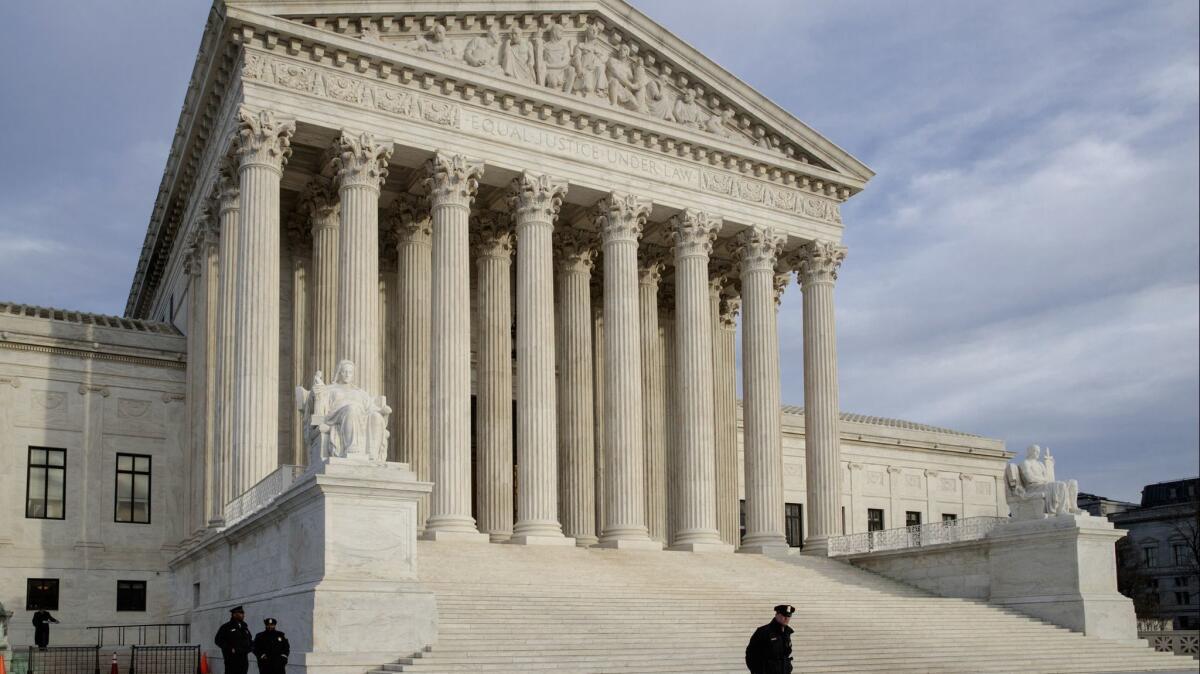Supreme Court upholds federal power to detain and deport immigrants for long-past crimes

- Share via
Reporting from Washington — A divided Supreme Court on Tuesday bolstered the Trump administration’s power to arrest and indefinitely jail legal immigrants who committed past crimes that could trigger deportation, including those who completed their sentences years ago or were convicted of minor drug offenses.
The court’s five conservatives pointed to a “mandatory detention” rule in a 1996 immigration law that said federal agents “shall take into custody” immigrants who have been convicted of certain crimes that would lead to deportation.
Tuesday’s high court decision is the third in the last two years that strengthens Trump’s authority under the immigration laws. While the ruling interprets a 1996 law, it takes on added significance because the administration has been more aggressive in arresting and jailing immigrants.
The justices in the majority said Congress feared it would be “too risky” to let terrorists or dangerous criminals go free while deportation was pending. But their opinion conceded the law is so broad it also sweeps in nonviolent “drug offenders and tax cheats.”
The 9th Circuit Court of Appeals, acting on an American Civil Liberties Union class-action suit in California, ruled in 2016 that these immigrants were not subject to mandatory detention if they were not “promptly” taken into custody after their release from a local jail or state prison. This spared those who had lived and worked legally in California, some for over a decade.
But Justice Samuel A. Alito Jr., speaking for the 5-4 majority, called this argument “hard to swallow” since local officials in so-called sanctuary cities do not alert federal agents when an immigrant is released.
In the case, Nielsen vs. Preap, he said the law calls for mandatory detention of the immigrants without exception and regardless of when they are taken into custody.
Last June, a 5-4 majority upheld the travel ban and said the president could deny entry to immigrants and visitors from several Muslim-majority nations. A few months earlier, the court ruled the government could hold immigrants for months or years without offering them a bail hearing. That decision, in Jennings vs. Rodriquez, was an offshoot of the case decided Tuesday.
Justice Stephen G. Breyer, speaking for the court’s four liberals, read his dissent in the courtroom. “The greater importance of the case lies in the power that the majority’s interpretation grants to the government. It is a power to detain persons who committed a minor crime many years before,” he said. “And it is a power to hold those persons, perhaps for many months, without any opportunity to obtain bail.”
He said the Constitution gave all people the right to a hearing if they were held by the government. “I would have thought that Congress intended to adhere to these values and did not intend to allow the government to apprehend persons years after their release from prison and hold them indefinitely without a bail hearing,” Breyer said. Justices Ruth Bader Ginsburg, Sonia Sotomayor and Elena Kagan agreed.
Joining Alito in the majority were Chief Justice John G. Roberts Jr. and Justices Clarence Thomas, Neil M. Gorsuch and Brett M. Kavanaugh. In a separate opinion, Thomas and Gorsuch said they would have thrown out the suit on the grounds the courts have no authority to review class-action suits challenging immigration enforcement.
ACLU Deputy Legal Director Cecillia Wang, who argued the case, criticized the ruling. “For two terms in a row now, the Supreme Court has endorsed the most extreme interpretation of immigration detention statutes,” she said, “allowing mass incarceration of people without any hearing, simply because they are defending themselves against a deportation charge. We will continue to fight the gross overuse of detention in the immigration system.”
Eduardo Padilla, one of the named plaintiffs, came to the United States in 1966 as an infant and became a lawful permanent resident in the Sacramento area. He has five children and six grandchildren, all of whom are U.S. citizens. Padilla had two convictions for drug possession, in 1997 and 1999, and served 90 days in jail in 2002 for having an unloaded pistol in a shed.
In 2013, federal agents rearrested him over those crimes and held him for deportation. But he went free after the 9th Circuit ruled the “mandatory detention” provision did not apply to immigrants such as Padilla. He was released on a $1,500 bond because a judge decided he did not present a danger and was not likely to flee.
The lead plaintiff in the case, Mony Preap, came from Cambodia as a child and had been a lawful U.S. resident since 1981. He was taken into custody over two convictions for possessing marijuana in 2006, but an immigration judge later canceled his deportation and he was released.
The Criminal Justice Legal Foundation in Sacramento welcomed the ruling. Kent Scheidegger, its legal director, said “the 9th Circuit’s ruling had misinterpreted the law in order to allow alien criminals in sanctuary cities to avoid detention and deportation under federal law. Congress required mandatory detention for those convicted of aggravated felonies for good reason.”
The high court heard arguments on the case in mid-October, the same week that Kavanaugh took his seat. He spoke up in defense of the Trump administration’s view that the law was intended to authorize federal agents to arrest and hold immigrants with crimes on their records regardless of when they were released. He questioned whether “we should be putting in a time limit” on taking immigrants into custody.
In a short concurring opinion on Tuesday, Kavanaugh said the issue before the court was “narrow.” It did not involve who will be deported or how long they will be held. “It would be odd, in my view,” he added, to read the law as exempting certain noncitizens from mandatory detention simply because the government “failed to immediately detain them upon their release.”
More stories from David G. Savage »
More to Read
Get the L.A. Times Politics newsletter
Deeply reported insights into legislation, politics and policy from Sacramento, Washington and beyond. In your inbox twice per week.
You may occasionally receive promotional content from the Los Angeles Times.











